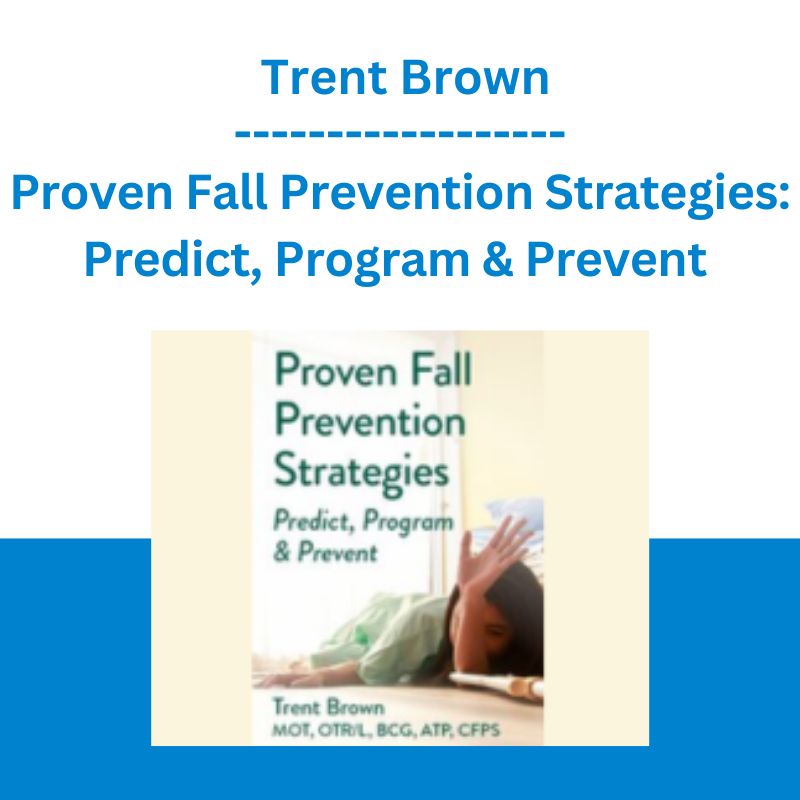*** Proof of Product ***
Exploring the Essential Features of “Proven Fall Prevention Strategies: Predict, Program & Prevent – Trent Brown”
One fall can turn your patient’s life upside down, resulting in rapidly declining health, extended hospital stays, monetary loss, fear, and isolation.
This session will hit all the highlights to help patients avoid falls while retaining the strength, balance and mobility it takes to stay functionally independent. Trent Brown MOT, OTR/L, BCG, ATP, CFPS, CGS will explore evidence-based strategies including patient teaching, home modifications, fall reduction programs, diet (hypovitaminosis), medication management, dual-task training, eye movement behaviors, visual deficits, and specific activities that reduce or prevent falls.
Discover practical solutions to some of the most challenging real-life situations you face with patients who fall or are at risk of falling. Built on today’s best practices, this training will provide you exactly what you need so you can …
- Better predict and prevent falls with effective fall prevention tools and strategies
- Design an individualized plan of care for patients who are high risk for falls
- Restore mobility and function with interventions and assistive technologies
- Perform validated fall assessments with categorization options for risk level
- Build your professional reputation as a go-to resource on fall prevention
Speaker
Trent Brown, MOT, OTR/L, BCG, ATP, CFPS
Advanced Healthcare
Trent Brown, MOT, OTR/L, BCG, ATP, CFPS, CGS, is a practicing therapist in Utah and is one of 36 credential holders of a board certification in gerontology (BCG) from the AOTA. Mr. Brown also holds a certification as an assistive technology professional (ATP) from RESNA. He completed his undergraduate and graduate work at the University of Utah where he is also an adjunct professor. He is employed by the Utah Department of Health (UDOH) to develop, implement, and operate healthcare quality improvement programs and has authored multiple laws to legislate improved patient care. Mr. Brown also reviews clinical documentation for UDOH as an expert witness in reviewing cases. Mr. Brown has over 15 years of clinical experience in skilled nursing, transitional care, acute, and home health. Recently, he served as the VP for the UOTA where he co-authored SB 131, advancing OT practice in the state of Utah, and has received multiple awards for his clinical, academic, and legislative work. Through his expertise in advocating for therapy services authoring law and rule, he has evolved into an expert presenter on ethical and legal issues facing therapy. Mr. Brown has provided courses for thousands of clinicians throughout the country in conferences, private settings, and specialty conferences. Mr. Brown is a master clinician and lecturer on a myriad of topics including joint arthroplasty, core strengthening, documentation, aging, functional mobility, ethics, and fall reduction. He has also been a keynote speaker at multiple events throughout the country.
Speaker Disclosures:
Financial: Trent Brown has employment relationships with the Utah Department of Health and the University of Utah. He receives compensation as a national speaker. Trent Brown receives a speaking honorarium and recording royalties from PESI, Inc. He has no relevant financial relationships with ineligible organizations.
Non-financial: Trent Brown has no relevant non-financial relationships.
Objectives
- Evaluate the evidence-based predictors that contribute to falls.
- Plan an individualized patient fall reduction program.
- Complete fall risk assessments to develop a plan of care for the high risk fall patient.
- Incorporate specific clinical strategies, exercises, activities, and educational resources to address fall risk reduction.
Outline
Evidence-Based Predictors Leading to Falls
- Where do falls occur?
- intrinsic/extrinsic/environmental factors
- Predictors of falls
- What does not work to prevent falls
- Fall risk factors
Components of a Successful Fall Reduction Program
- Combination of interventions
- Individualized
- Trained clinicians
- Individual accountability
Fall Assessments: Design a Plan of Care for High Risk Fall Patients
- FRT
- STEADI
- HSSAT
- 10 M walk test
- What is not reliable as a single test?
- TUG, BERG, Chair Stand, etc.
Reduce Fall Risks: Specific Therapeutic Strategies, Exercises, Activities, & Educational Resources
- Strategies to address fall risks
- FOF
- Eye movement behaviors
- UE Strength
- FAST
- Visual impairment
- Medications
- Depression
- Biological sex and fallsAnterior vs. posterior pelvic tilt
- Vitamin D
- Hypovitaminosis
- IU recommendation
- Clinician education
- Sleep
- Home modifications
Please see the full list of alternative group-buy courses available here: https://lunacourse.com/shop/










 Emanuele Bonanni - My Trading Way
Emanuele Bonanni - My Trading Way  Simpler Trading - Bruce Marshall - The Options Defense Course
Simpler Trading - Bruce Marshall - The Options Defense Course